brake Citroen DS3 DAG 2009.5 1.G Owner's Manual
[x] Cancel search | Manufacturer: CITROEN, Model Year: 2009.5, Model line: DS3 DAG, Model: Citroen DS3 DAG 2009.5 1.GPages: 244, PDF Size: 7.12 MB
Page 5 of 244
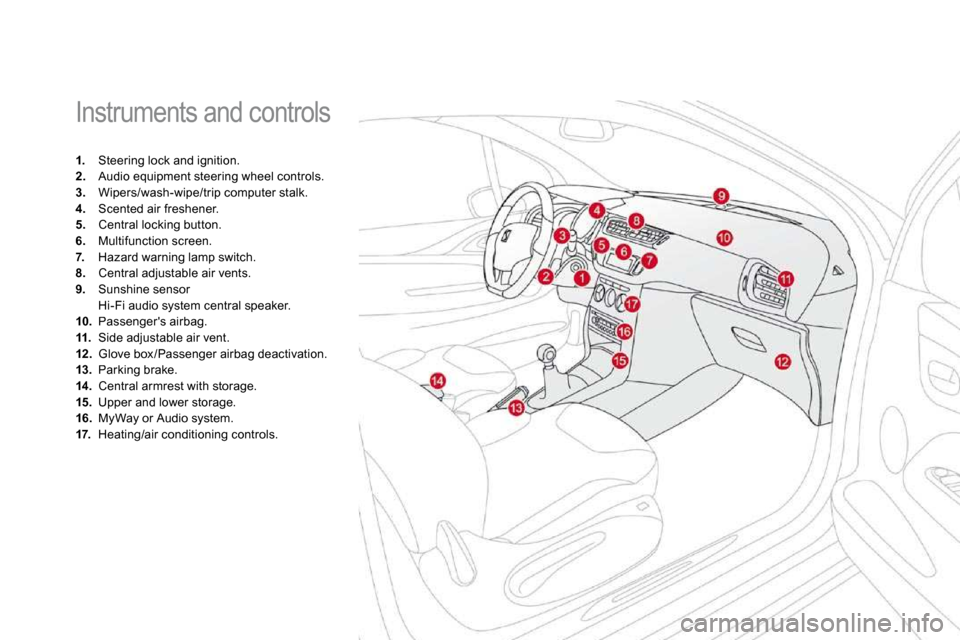
Instruments and controls
1. Steering lock and ignition. 2. Audio equipment steering wheel controls. 3. Wipers/wash-wipe/trip computer stalk. 4. Scented air freshener. 5. Central locking button. 6. Multifunction screen. 7. Hazard warning lamp switch. 8. Central adjustable air vents. 9. Sunshine sensor Hi-Fi audio system central speaker. 10. Passenger's airbag. 11. Side adjustable air vent. 12. Glove box /Passenger airbag deactivation. 13. Parking brake. 14. Central armrest with storage. 15. Upper and lower storage. 16. MyWay or Audio system. 17. Heating/air conditioning controls.
Page 18 of 244

Warning lampis onCauseAction/Obser vations
Diesel engine pre-heating fixed. The ignition switch is at the 2 nd position (ignition on). Wait until the warning lamp has switched off before starting. The duration for which the warning lamp is on is determined by the climatic conditions.
Parking brake fixed. The parking brake is applied or not properly released. Release the parking brake to switch off the warnin g lamp, keeping your foot on the brake pedal. Obser ve the safety recommendations. For fur ther information on the parking brake, refer t o the "Driving" section.
Engine coolant temperature fixed blue. On star ting the engine, it indicates that the engine is cold. After a few minutes driving, it swiches off to indicate that the engine temperature is normal. In order to protect your engine, avoid driving too hard until the warning lamp has switched off.
Foot on the brake pedal fixed. With an automatic gearbox, you have forgotten to press the brake pedal to come out of the P postion.
With the engine running, before releasing the park ing brake you must press the brake pedal to unlock the the automatic gear selector lever and come out of the P position.
Automatic wiping fixed. The wiper control is pushed downwards. Automatic front wiping is activated.
Passenger's airbag system fixed. The control switch, located in the glove box, is in the " ON " position. The passenger's front airbag is activated. In this case, do not install a rear-facing child seat.
Turn the control switch to the " OFF " position to deactivate the front passenger's airbag. In this case you can install a rear-facing child seat. The passenger's airbag system is automatically put into ser vice on star ting the vehicle (" ON " position).
Page 21 of 244
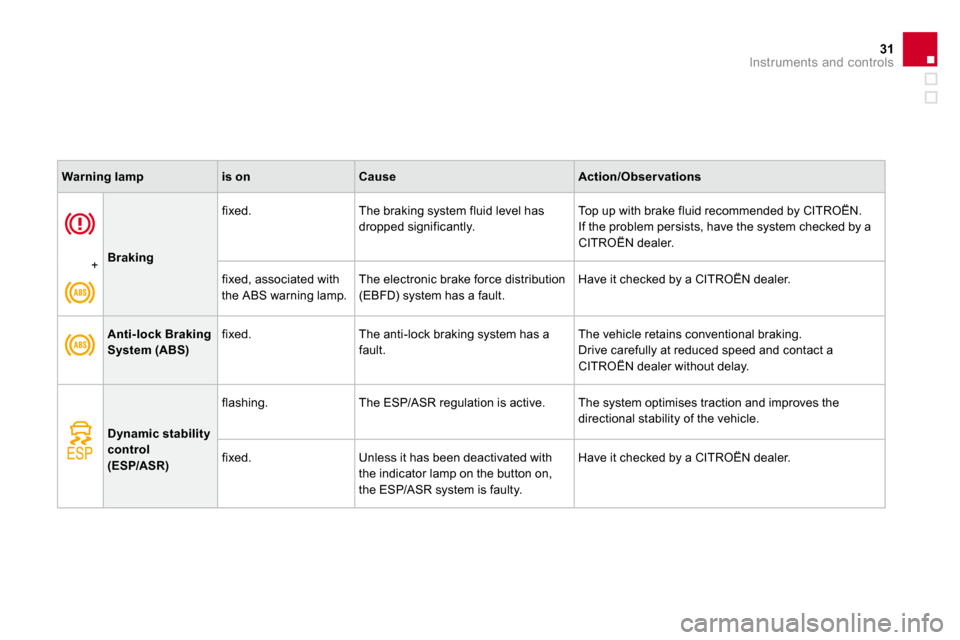
31Instruments and controls
Braking
fixed. The braking system fluid level has
dropped significantly.
Top up with brake fluid recommended by CITROËN.
If the problem persists, have the system checked by a CITROËN dealer.
+ fixed, associated with the ABS warning lamp. The electronic brake force distribution (EBFD) system has a fault. Have it checked by a CITROËN dealer.
Warning lampis onCauseAction/Obser vations
Anti-lock Braking System (ABS) fixed. The anti-lock braking system has a fault. The vehicle retains conventional braking. Drive carefully at reduced speed and contact a CITROËN dealer without delay.
Dynamic stability control (ESP/ASR)
flashing. The ESP/ASR regulation is active. The system optimises traction and improves the directional stability of the vehicle.
fixed. Unless it has been deactivated with the indicator lamp on the button on, the ESP/ASR system is faulty.
Have it checked by a CITROËN dealer.
Page 123 of 244
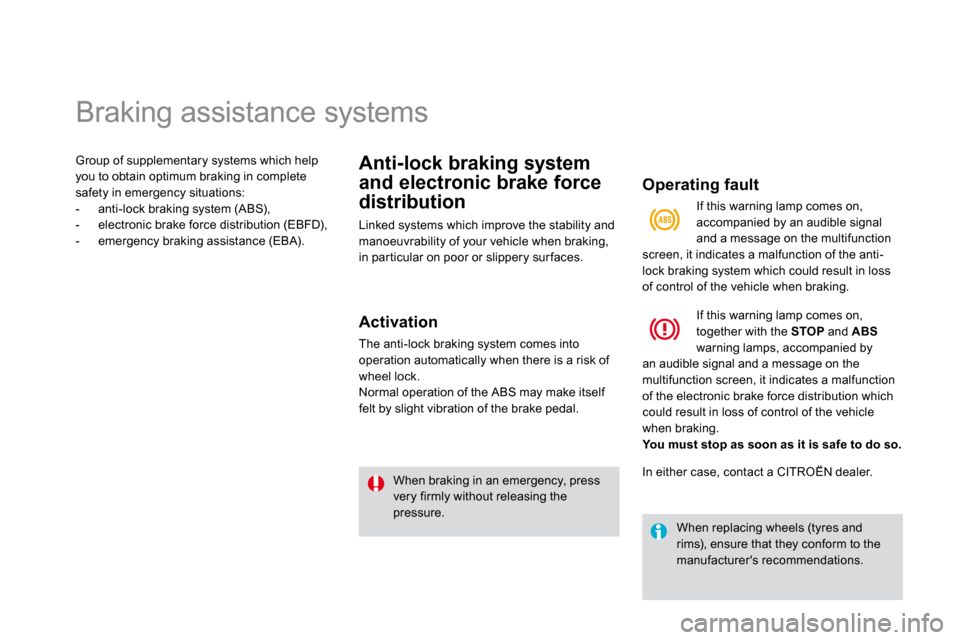
Braking assistance systems
Group of supplementary systems which help you to obtain optimum braking in complete safety in emergency situations: - anti-lock braking system (ABS), - electronic brake force distribution (EBFD), - emergency braking assistance (EBA).
Anti-lock braking system
and electronic brake force
distribution
Linked systems which improve the stability and manoeuvrability of your vehicle when braking, in par ticular on poor or slippery sur faces.
Activation
The anti-lock braking system comes into operation automatically when there is a risk of wheel lock. Normal operation of the ABS may make itself felt by slight vibration of the brake pedal.
When braking in an emergency, press very firmly without releasing the pressure.
Operating fault
If this warning lamp comes on, together with the STOP and ABSwarning lamps, accompanied by an audible signal and a message on the multifunction screen, it indicates a malfunction of the electronic brake force distribution which could result in loss of control of the vehicle when braking. You must stop as soon as it is safe to do so.
When replacing wheels (tyres and rims), ensure that they conform to the manufacturer's recommendations.
If this warning lamp comes on, accompanied by an audible signal and a message on the multifunction screen, it indicates a malfunction of the anti-lock braking system which could result in loss of control of the vehicle when braking.
In either case, contact a CITROËN dealer.
Page 124 of 244

131Safety
Emergency braking
assistance
System which, in an emergency, enables you to obtain the optimum braking pressure more quickly, thus reducing the stopping distance.
Activation
It is triggered by the speed at which the brake pedal is pressed. The effect of this is a reduction in the resistance of the pedal and an increase in braking efficiency.
When braking in an emergency, press firmly without releasing the pressure.
Trajectory control systems
Anti-skid regulation (ASR)
and electronic stability
programme (ESP)
The anti-skid regulation (also known as Traction Control) optimises traction to prevent skidding of the wheels, by acting on the brakes of the driving wheels and on the engine. The electronic stability programme acts on the brake of one or more wheels and on the engine to keep the vehicle on the trajectory required by the driver, within the limits of the laws of physics.
Activation
These systems are activated automatically each time the vehicle is star ted. They come into operation in the event of a grip or trajectory problem.
This is indicated by flashing of this warning lamp on the instrument panel.
Page 125 of 244
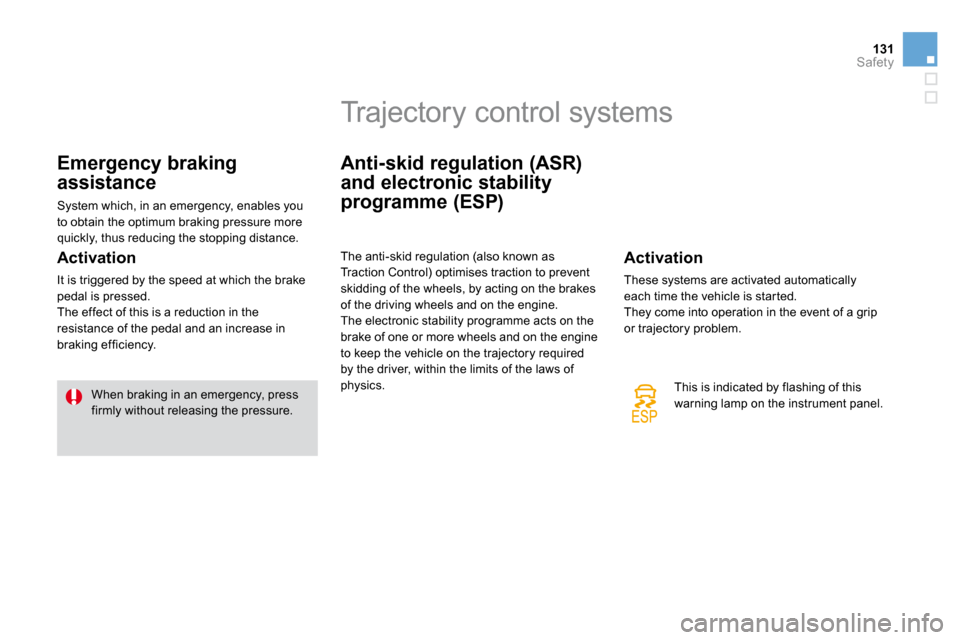
131Safety
Emergency braking
assistance
System which, in an emergency, enables you to obtain the optimum braking pressure more quickly, thus reducing the stopping distance.
Activation
It is triggered by the speed at which the brake pedal is pressed. The effect of this is a reduction in the resistance of the pedal and an increase in braking efficiency.
When braking in an emergency, press firmly without releasing the pressure.
Trajectory control systems
Anti-skid regulation (ASR)
and electronic stability
programme (ESP)
The anti-skid regulation (also known as Traction Control) optimises traction to prevent skidding of the wheels, by acting on the brakes of the driving wheels and on the engine. The electronic stability programme acts on the brake of one or more wheels and on the engine to keep the vehicle on the trajectory required by the driver, within the limits of the laws of physics.
Activation
These systems are activated automatically each time the vehicle is star ted. They come into operation in the event of a grip or trajectory problem.
This is indicated by flashing of this warning lamp on the instrument panel.
Page 136 of 244

Parking brake
Applying
� Pull the parking brake lever fully up to immobilise your vehicle.
Releasing
� Pull the parking brake lever gently, press the release button then lower the lever fully.
When parking on a slope, direct your wheels against the pavement, apply the parking brake and engage a gear.
When the vehicle is being driven, if this warning lamp and the STOP warning lamp come on, accompanied by an
audible signal and a message on the multifunction screen, this indicates that the parking brake is still on or has not been properly released.
Page 139 of 244
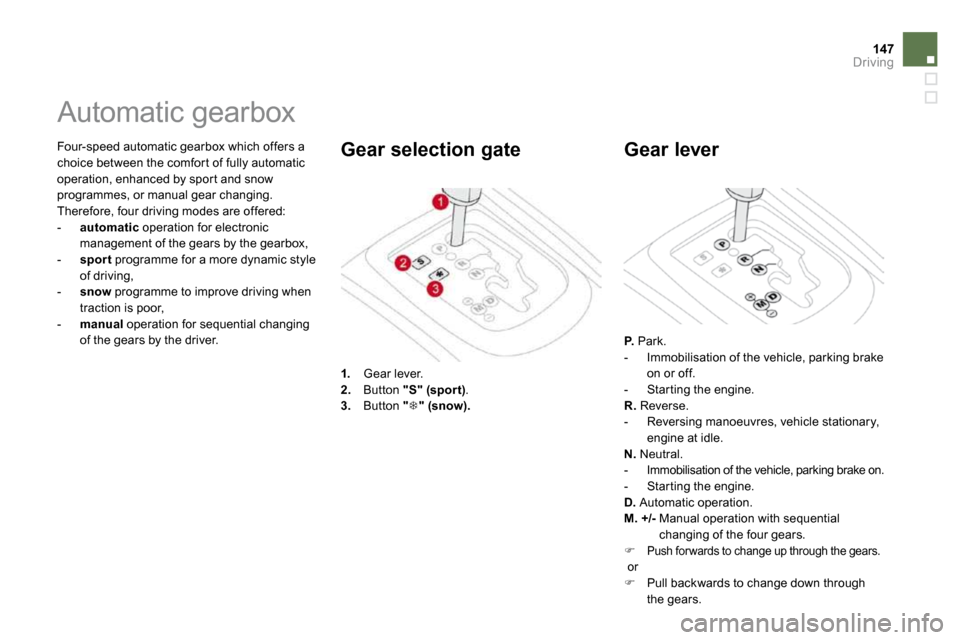
147Driving
Four-speed automatic gearbox which offers a choice between the comfor t of fully automatic operation, enhanced by spor t and snow programmes, or manual gear changing. Therefore, four driving modes are offered:
- automatic operation for electronic management of the gears by the gearbox, - spor t programme for a more dynamic style of driving, - snow programme to improve driving when traction is poor, - manual operation for sequential changing of the gears by the driver.
Automatic gearbox
1. Gear lever. 2. Button "S" (spor t) . 3. Button "�" (snow).
Gear selection gate
P. Park. - Immobilisation of the vehicle, parking brake on or off. - Star ting the engine. R. Reverse. - Reversing manoeuvres, vehicle stationary,
engine at idle. N. Neutral. - Immobilisation of the vehicle, parking brake on.
- Star ting the engine. D. Automatic operation. M. +/- Manual operation with sequential
changing of the four gears. �Push forwards to change up through the gears. or � Pull backwards to change down through the gears.
Gear lever
Page 140 of 244
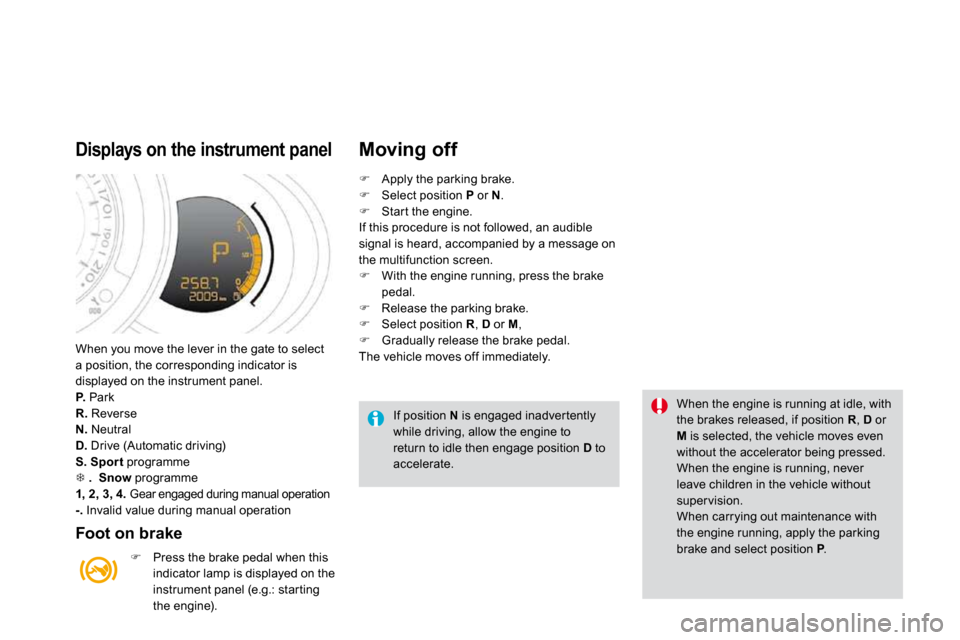
When you move the lever in the gate to select a position, the corresponding indicator is displayed on the instrument panel. P. Park R. Reverse N. Neutral D. Drive (Automatic driving) S. Spor t programme � . Snow programme 1, 2, 3, 4. Gear engaged during manual operation -. Invalid value during manual operation
Displays on the instrument panel
Foot on brake
� Press the brake pedal when this indicator lamp is displayed on the instrument panel (e.g.: star ting the engine).
Moving off
If position N is engaged inadver tently while driving, allow the engine to return to idle then engage position D to accelerate.
When the engine is running at idle, with the brakes released, if position R , D or
M is selected, the vehicle moves even without the accelerator being pressed. When the engine is running, never leave children in the vehicle without super vision. When carrying out maintenance with the engine running, apply the parking brake and select position P . PP
� Apply the parking brake. � Select position P or N . � Star t the engine. If this procedure is not followed, an audible signal is heard, accompanied by a message on the multifunction screen. � With the engine running, press the brake pedal. � Release the parking brake. � Select position R , D or M , � Gradually release the brake pedal. The vehicle moves off immediately.
Page 142 of 244
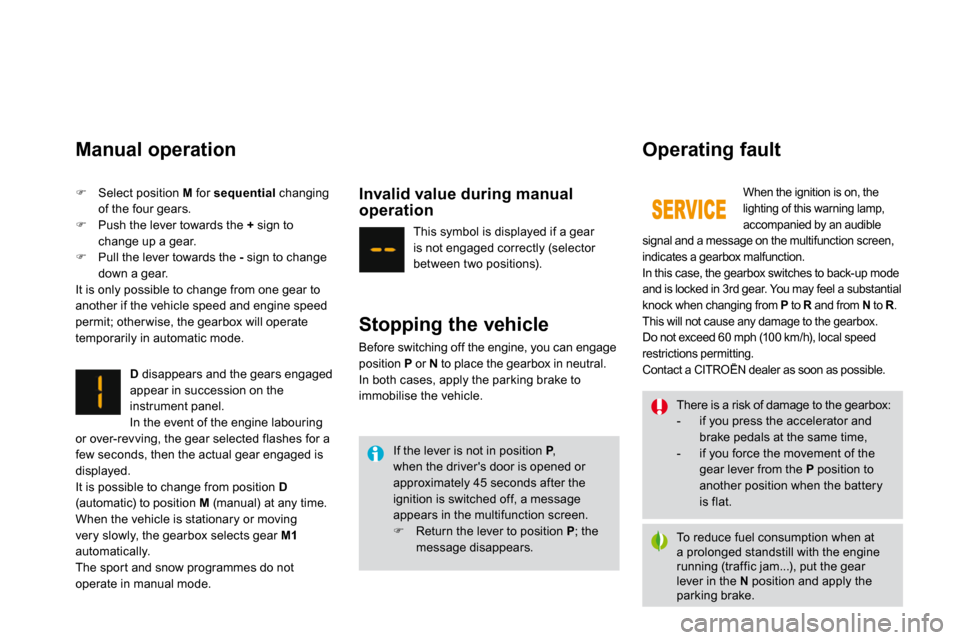
Manual operation
D disappears and the gears engaged appear in succession on the instrument panel. In the event of the engine labouring or over-revving, the gear selected flashes for a few seconds, then the actual gear engaged is displayed.
It is possible to change from position D(automatic) to position M (manual) at any time. When the vehicle is stationary or moving very slowly, the gearbox selects gear M1automatically. The spor t and snow programmes do not operate in manual mode.
Invalid value during manual operation
� Select position M for sequential changing of the four gears. � Push the lever towards the + sign to change up a gear. � Pull the lever towards the - sign to change down a gear. It is only possible to change from one gear to another if the vehicle speed and engine speed permit; other wise, the gearbox will operate temporarily in automatic mode.
This symbol is displayed if a gear is not engaged correctly (selector between two positions).
Stopping the vehicle
Before switching off the engine, you can engage position P or N to place the gearbox in neutral. In both cases, apply the parking brake to immobilise the vehicle.
When the ignition is on, the lighting of this warning lamp,
accompanied by an audible signal and a message on the multifunction screen, indicates a gearbox malfunction. In this case, the gearbox switches to back-up mode and is locked in 3rd gear. You may feel a substantial knock when changing from P to R and from RN to R . RRThis will not cause any damage to the gearbox. Do not exceed 60 mph (100 km/h), local speed restrictions permitting. Contact a CITROËN dealer as soon as possible.
Operating fault
If the lever is not in position P , Pwhen the driver's door is opened or approximately 45 seconds after the ignition is switched off, a message appears in the multifunction screen. � Return the lever to position P ; the
message disappears.
There is a risk of damage to the gearbox: - if you press the accelerator and
brake pedals at the same time, - if you force the movement of the gear lever from the P position to
another position when the battery is flat.
To reduce fuel consumption when at a prolonged standstill with the engine running (traffic jam...), put the gear lever in the N position and apply the parking brake.